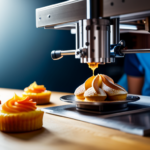Did you know that 3D printed food is revolutionizing the culinary industry, with the global 3D food printing market expected to reach $525.6 million by 2023?
In this comprehensive guide, we delve into the intricacies of designing 3D printed foods, from understanding the technology and selecting edible materials to creating custom food shapes and infusing flavors.
Whether you’re a novice or a seasoned professional, this article will equip you with the knowledge and techniques to explore the exciting world of 3D printed foods.
Understanding 3D Printing Technology
Understanding 3D printing technology is essential for anyone looking to design and create 3D printed foods. The process of 3D printing, also known as additive manufacturing, involves creating three-dimensional objects from a digital file by layering materials such as plastic, metal, or in the case of food, edible ingredients.
In the food industry, 3D printing has gained traction due to its applications in creating intricate designs, customized nutrition, and unique culinary experiences. This technology allows for the production of complex shapes and structures that are challenging to achieve using traditional methods, offering innovative possibilities for food presentation and consumption.
The 3D printing process begins with creating a digital model of the desired food product, which is then sliced into thin horizontal cross-sections. The 3D printer interprets these 2D slices and deposits the edible material layer by layer, gradually building up the final 3D edible object. Using this technology, chefs and food designers can craft visually stunning dishes, personalized nutrition options, and even cater to individuals with specific dietary requirements or restrictions.
Understanding the intricacies of 3D printing in the food industry is crucial for harnessing its potential to revolutionize culinary practices and consumer experiences.
Choosing Edible Materials
When selecting edible materials for 3D printed foods, it is imperative to consider their taste, texture, and nutritional properties in order to create innovative and appealing culinary experiences.
-
Edible Ingredients: The choice of edible ingredients for 3D printed foods is crucial. It is essential to select ingredients that are not only safe for consumption but also suitable for the 3D printing process, ensuring that they can be extruded or powdered effectively.
-
Safety Considerations: Ensuring the safety of the edible materials used in 3D printed foods is paramount. It is vital to assess the potential risks associated with the chosen ingredients, considering factors such as allergens, microbiological safety, and any chemical hazards that may arise during the 3D printing and food processing stages.
-
Nutritional Properties: The nutritional value of the edible materials plays a significant role in 3D printed foods. It is important to select ingredients that contribute to a balanced and healthy diet, providing essential nutrients while also catering to dietary restrictions and preferences.
Careful consideration of these factors is essential to ensure that the chosen edible materials not only meet safety standards but also contribute to the overall quality and appeal of the 3D printed foods.
Designing Custom Food Shapes
How can 3D printing technology be utilized to create custom shapes for a variety of food products?
Designing custom food shapes through 3D printing involves a meticulous understanding of food safety and innovative presentation techniques.
To ensure food safety, it is crucial to use edible materials that are compliant with food regulations and safe for consumption. These materials should also be compatible with the 3D printing process to maintain the integrity of the food product.
Additionally, creative presentation techniques play a significant role in designing custom food shapes. The design process should consider not only the aesthetic appeal of the final product but also its structural integrity and overall consumer experience.
Utilizing 3D printing technology allows for intricate and detailed customization, enabling chefs and food designers to create unique shapes that were previously unattainable through traditional methods.
Exploring Flavor Infusion Techniques
Utilizing 3D printing technology for exploring flavor infusion techniques in food design requires a nuanced understanding of ingredient compatibility and precise execution. Infusing flavors and creating textures through 3D printed foods involves a blend of culinary innovation and scientific knowledge.
Here are three essential considerations for effectively infusing flavors and creating textures using 3D printing:
-
Ingredient Compatibility: Understanding the chemical reactions that occur when different ingredients are combined is crucial. This knowledge enables the creation of flavor-infused layers that complement each other harmoniously.
-
Precise Control of Texture: 3D printing allows for precise control over the texture of food. By adjusting parameters such as temperature, pressure, and nozzle size, chefs can create intricate textures that enhance the overall dining experience.
-
Innovative Flavor Combinations: 3D printing opens up possibilities for experimenting with unconventional flavor combinations. Chefs can explore unique pairings of ingredients, leading to the development of innovative and tantalizing culinary experiences.
Tips for Successful Printing
Achieving successful 3D printed food designs requires meticulous attention to detail and a thorough understanding of the printing process, as well as the culinary and scientific aspects involved.
When it comes to 3D printing food, troubleshooting common issues is essential for successful printing. One common issue is the consistency of the food material, as it needs to be precisely calibrated to ensure smooth printing. Additionally, maintaining the proper temperature throughout the printing process is crucial to prevent any clogging or uneven extrusion.
Furthermore, when printing intricate designs, it is important to consider the complexity of the design and the capabilities of the 3D printer. Some designs may require support structures or specific printing techniques to ensure that the final product is accurate and visually appealing. Understanding the limitations and capabilities of the 3D printer is essential for achieving successful results when printing intricate designs.
Frequently Asked Questions
Can 3D Printed Food Be Customized to Meet Specific Dietary Restrictions or Allergies?
3D printed food can be customized to cater to specific dietary restrictions or allergies by altering flavors, textures, and shapes. This innovative approach allows for the creation of allergen-free options and personalized nutrition profiles to meet individual needs.
Are There Any Safety Concerns When Using 3D Printed Food for Consumption?
Food safety is a crucial consideration when using 3D printed food. Regulations ensure compliance with safety standards. Material toxicity is a concern; thus, meticulous selection and testing of food-grade materials are essential for safe consumption.
How Long Does It Take to 3D Print a Single Food Item?
The printing speed and food item complexity determine the time to 3D print a single food item. Printing speed varies based on the intricacy of the design and the type of food being printed, with some items taking minutes and others hours to complete.
Can 3D Printed Food Be Stored for Extended Periods of Time?
When considering the shelf life and preservation of 3D printed food, it’s essential to address taste and texture retention. Innovative methods of packaging and storage are crucial to maintain quality over extended periods.
Are There Any Specific Design Considerations for Creating 3D Printed Food for Different Age Groups or Dietary Needs?
When designing 3D printed food for different age groups or dietary needs, specific considerations such as texture, flavor, and nutritional requirements must be addressed. Customization of food shapes and sizes can ensure age-appropriate and tailored dietary options.
Conclusion
In conclusion, designing 3D printed foods requires a deep understanding of 3D printing technology, the selection of edible materials, and the application of flavor infusion techniques.
According to a study by Research and Markets, the global 3D food printing market is projected to reach $525.6 million by 2027, with a compound annual growth rate of 50.9%.
This innovative approach to food design has the potential to revolutionize the way we think about food production and consumption.


